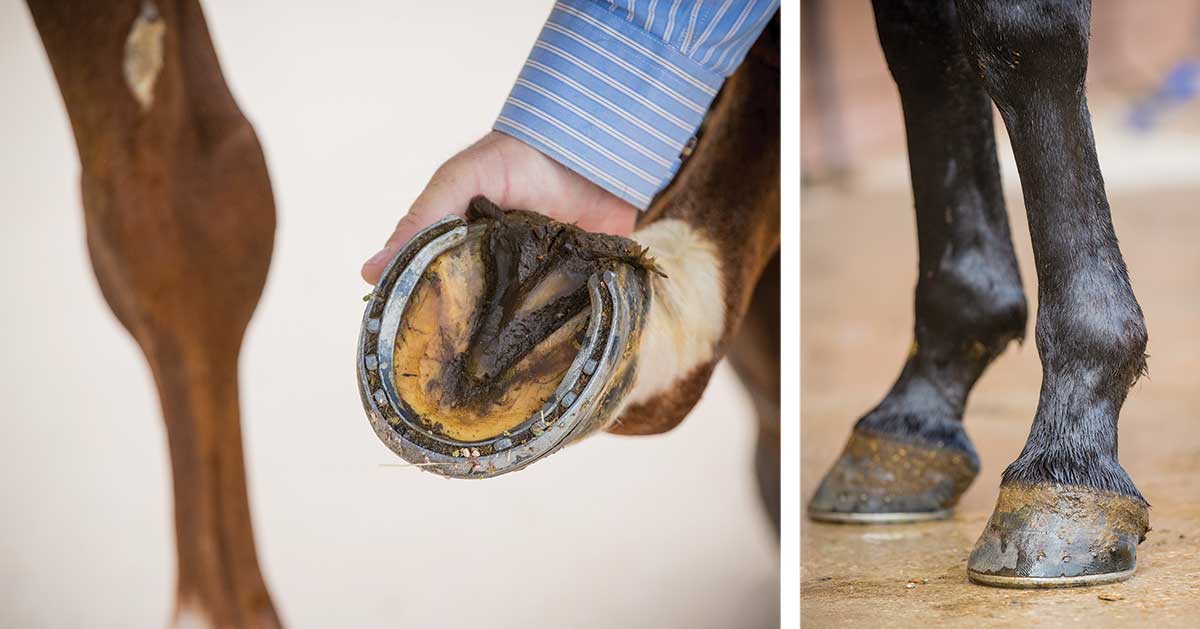
It’s been said that your horse is no better than his feet. They’re the primary contact with the ground as he carries you and your equipment over variable terrain along the trail, out on the ranch, or as you take laps around the arena. If you horse’s feet aren’t well cared for, he can’t do his job, and you can’t enjoy him.
Products we feature have been selected by our editorial staff. If you make a purchase using the links included, we may earn a commission. For more information click here.
Healthy feet come with daily care. Each time you’re with your horse, pick up his feet, clean them, and check that they’re in good condition. Remove rocks, and watch for hoof-wall cracks.
Daily maintenance helps ensure that your trail horse’s hooves are ready to withstand the stressors of the trail, be they sharp rocks, pebbles, slate, water, sand, or hard ground. If his hooves can’t handle the conditions, you’ll be calling it a day too early in your ride because of soreness or injury. Best-case scenario, your horse will just be uncomfortable.
Here I’ll share my hoof-care basics, as well as trail-specific considerations designed to help you and your horse have a safe, comfortable ride.
Protect His Hooves
A simple rule: If hoof wear exceeds hoof growth, then you must substitute that growth. Horseshoes and hoof boots fulfill this role.
Have your horse trimmed every six to eight weeks by a reputable professional farrier. Shoe consistently during peak riding season. Your horse’s hoof shape should complement his anatomy and consider his hoof’s growth pattern. A good farrier will shape the shoe to your horse’s hoof, not the other way around.
If you choose for your horse to go barefoot, use hoof boots when you ride on terrain that wears on feet. If your horse goes barefoot only during the off season, hoof boots protect his hooves while giving them a rest from shoes and allowing regrowth.
Wanting to try hoof boots? Amazon offers EasyCare options! Try the EasyCare EasyBoot Trail Hoof Boot or the EasyBoot Original Trail Boot.
Correctly fit and adjust hoof boots so your horse can achieve full pastern flexion. His foot contains veins and arteries that pump blood to and from his leg. If you restrict pastern flexion, you restrict blood flow elsewhere.
Do tightly secure the boots. Your horse can’t feel the outside of his hoof wall, so don’t be shy about cinching down the bootstraps. But avoid tightening too much near the coronary band, as this shuts off blood supply to the rest of his leg.
Test the boots before you get to the trailhead to ensure that they fit well. Boots are easily sucked off by mud, and a loose boot is even likelier to come off.

Teach Him Manners
To make hoof care stress-free, teach your horse manners. If he’s difficult to work with, he won’t get the best possible care from your farrier. It’s also a safety hazard for you if he’s unruly while being handled on and off the trail.
To help your horse become comfortable with the trimming and shoeing procedure, prepare him for the handling, sounds, and sensations he’ll experience with your farrier. When you pick your horse’s feet, have him stand a little longer than necessary to teach patience. Use a carpenter’s hammer to mock the feel and sound of trimming and shoeing. With the hammer’s claw, scrape the sole and outside of the hoof to mimic the rasp. Light, hammer-like motions emulate driving nails. (Avoid being too aggressive.)
If you don’t have a hammer in your barn, consider purchasing one here! Amazon offers a Estwing hammer that’s perfect for fixing things at the barn and getting your horse used to the farrier.
If you’ve worked with your horse and still have trouble, hire your farrier to help you work through the process of a successful shoeing. Your diligence on the frontend saves your farrier headaches and keeps you out of dangerous situations.
One Step at a Time
Your trail horse is at risk for a foot injury even on rock-free trails, so be prepared. You’d hate to have to end the ride because your horse fractures his hoof wall, is bleeding, or has a stone bruise, and you’re ill-prepared to handle it.
Carry supplies for hoof-related mishaps. We always pack a small rasp, such as Weaver’s RidersRasp, plus extra boots and shoes. It’s not practical to bring an entire set for each horse, but you shouldn’t be without a few spares. If you’re not comfortable tacking on a loose or lost shoe, simply use a hoof boot to tide your horse over until you can make it back to the trailer.
Gather your essential hoof-related supplies before your next ride. Amazon offers great prices on the Weaver Original RidersRasp, EasyBoot Original Trail Boots, and Diamond Farrier Classic horse shoes.
If you find yourself without hoof protection, stay on the softest ground possible, and avoid rocks as you head back, even if it means you dismount and walk. A few chips aren’t a big deal, but if you badly break up the hoof wall or give your horse a stone bruise, he can be out for months.
Trainer, clinician, and lifelong cowboy Ken McNabb hails from Lovell, Wyoming. He helps riders and horses build and enjoy partnerships working on the ranch and riding on the trail. His show, Discovering the Horseman Within, airs weekly on RFD-TV. Learn more about McNabb and find his clinic schedule at kenmcnabb.com.






